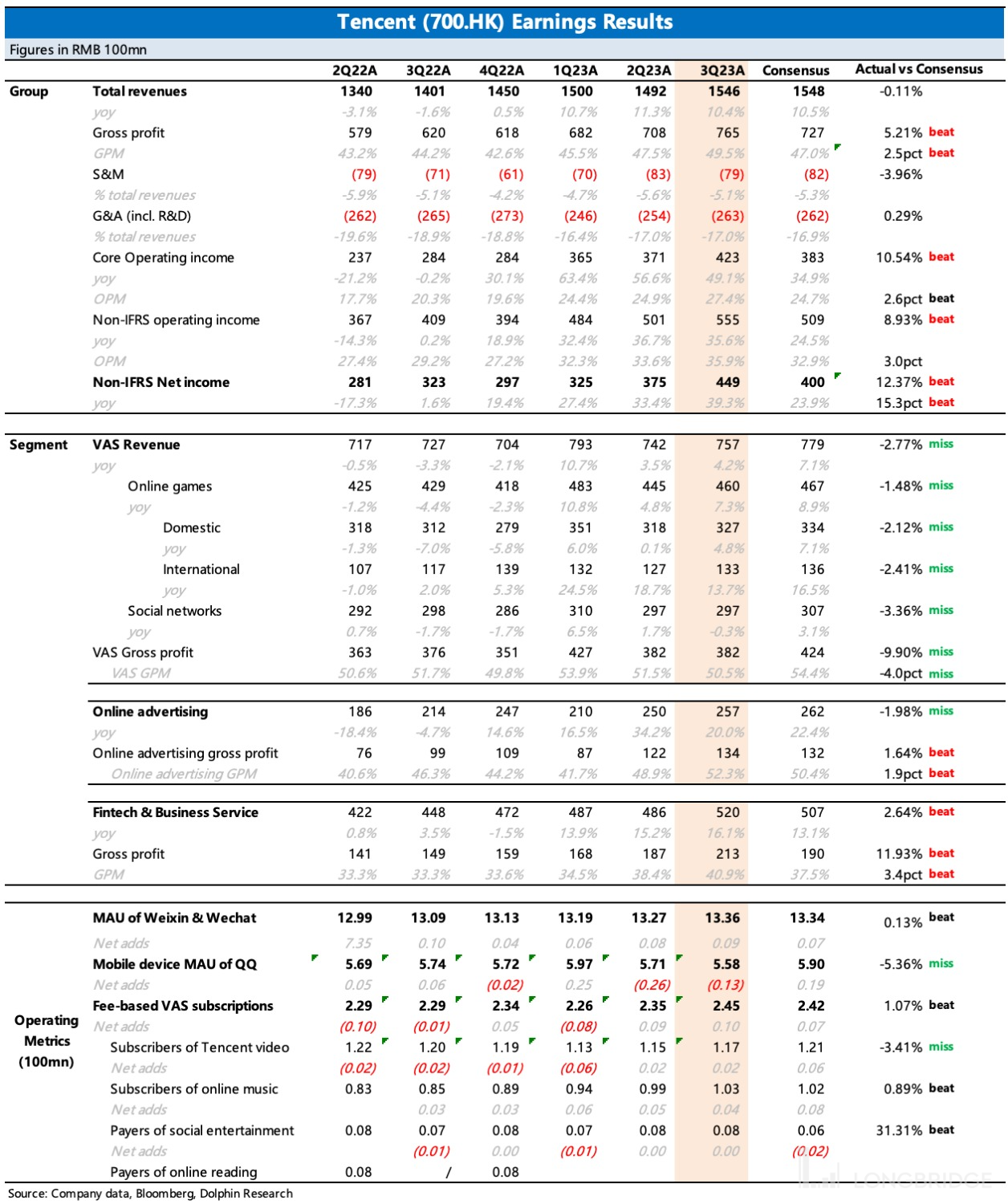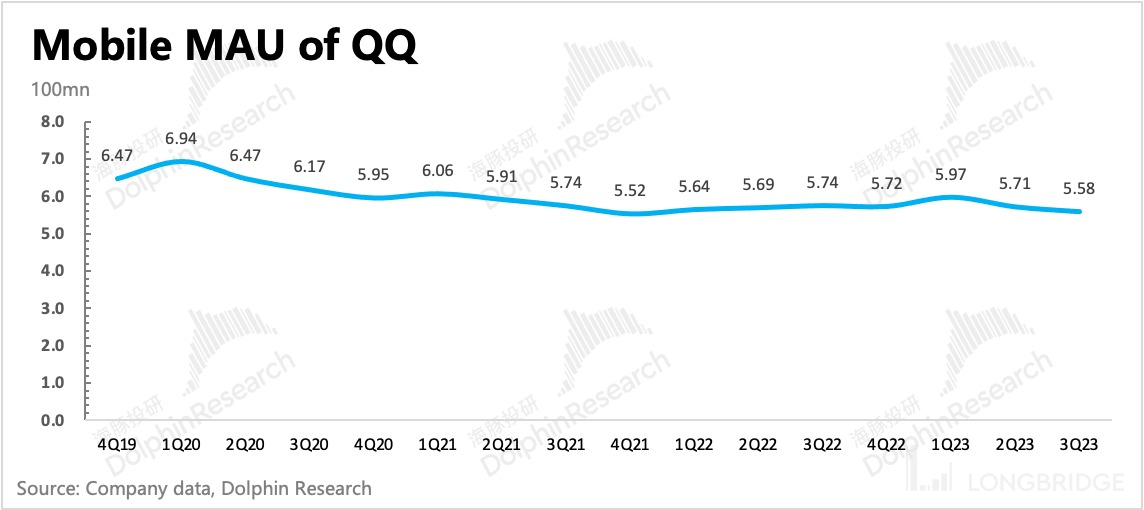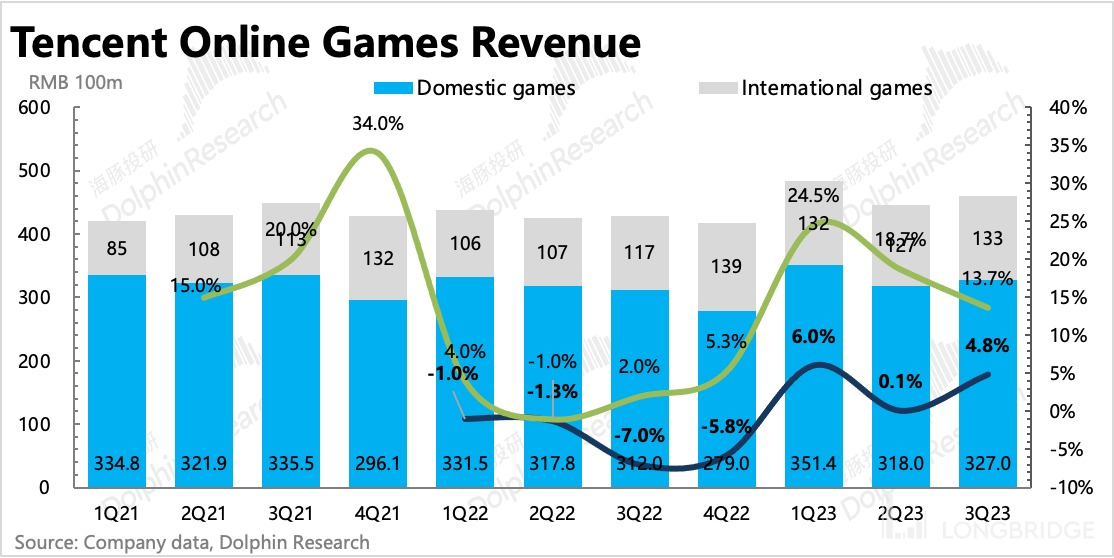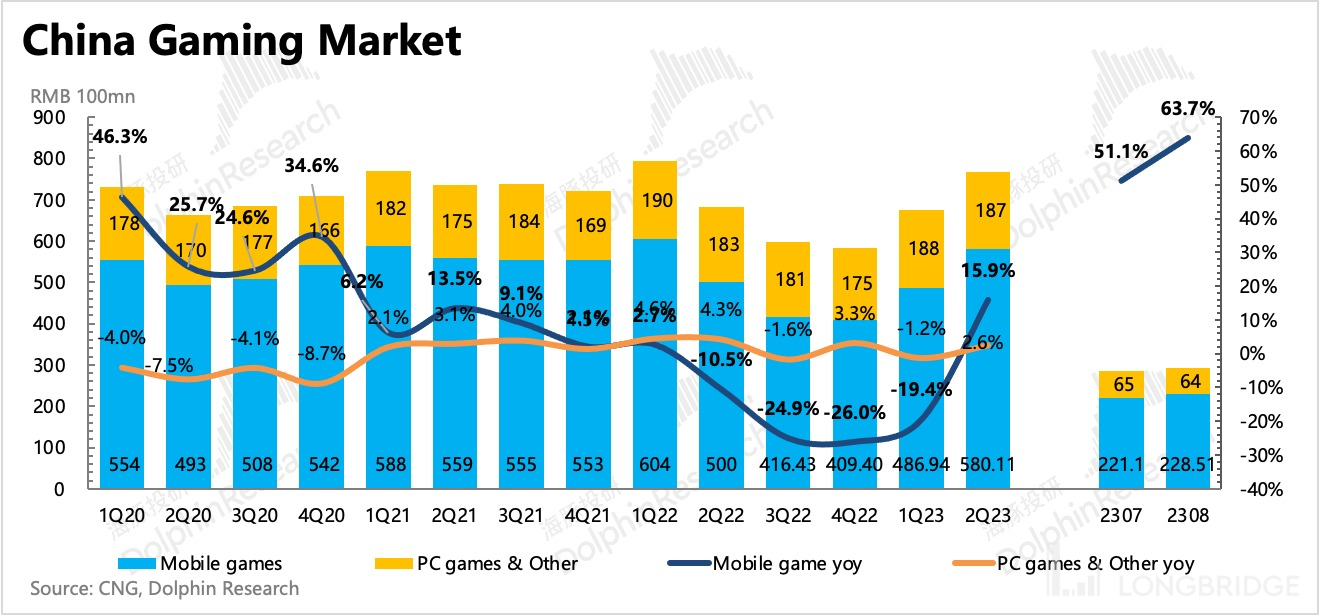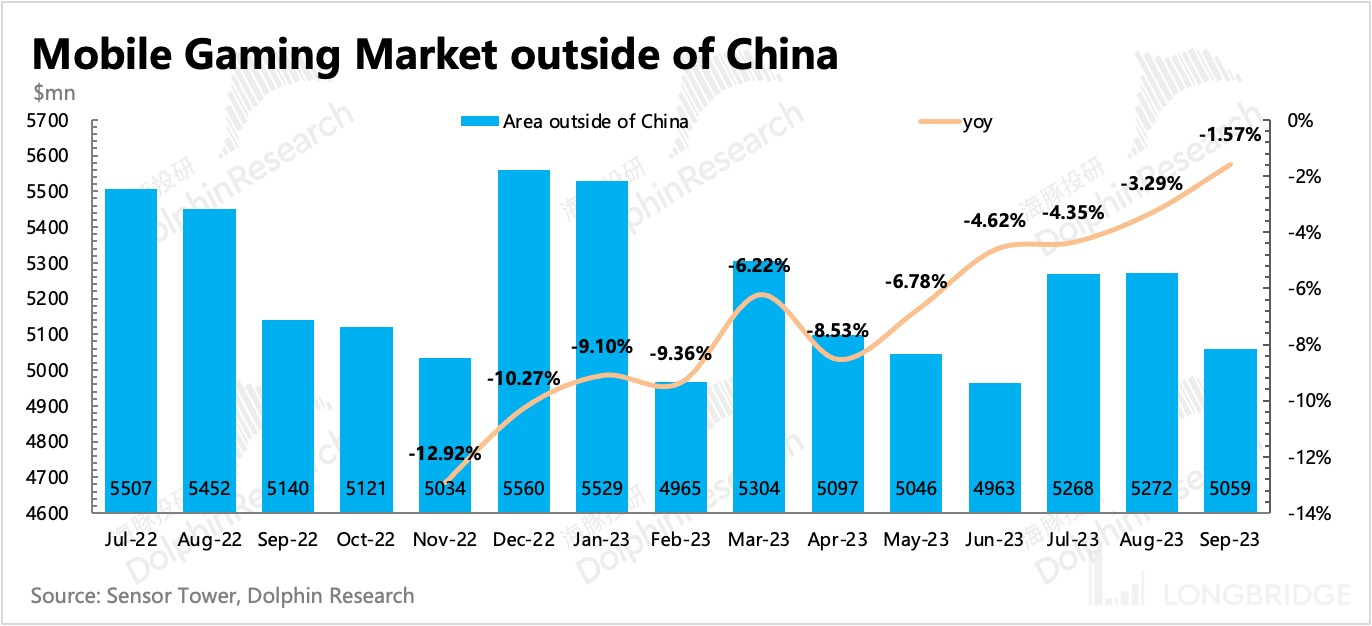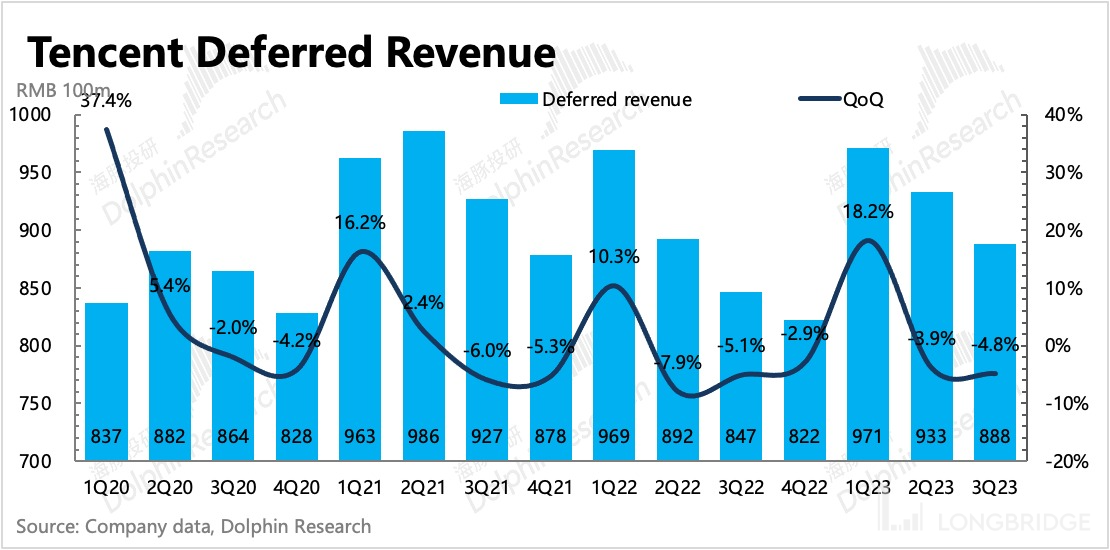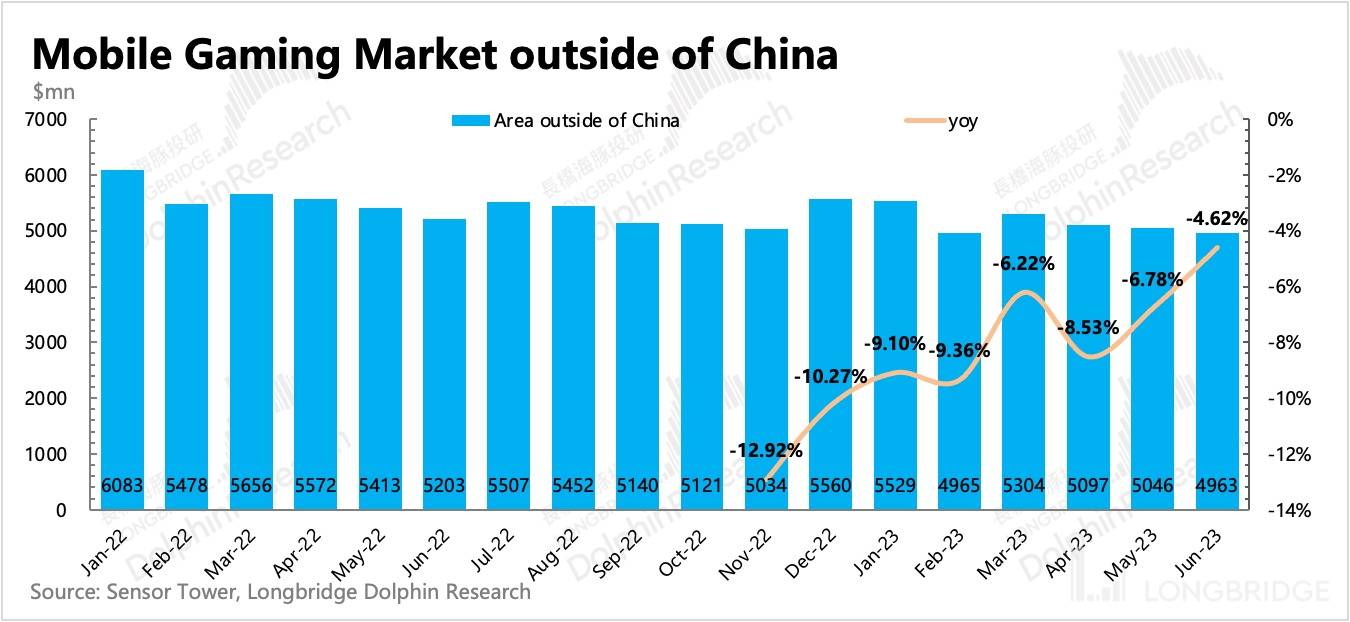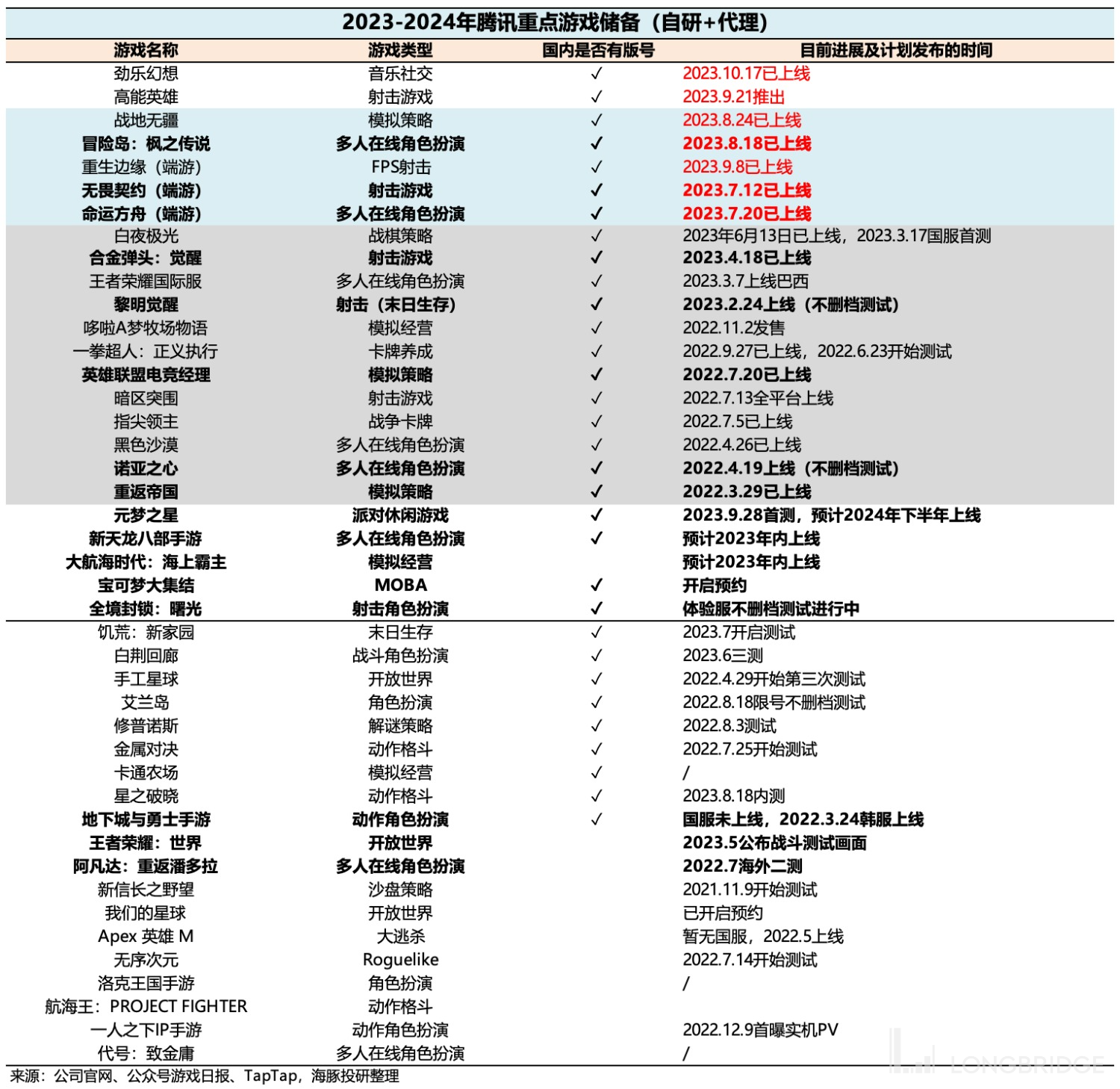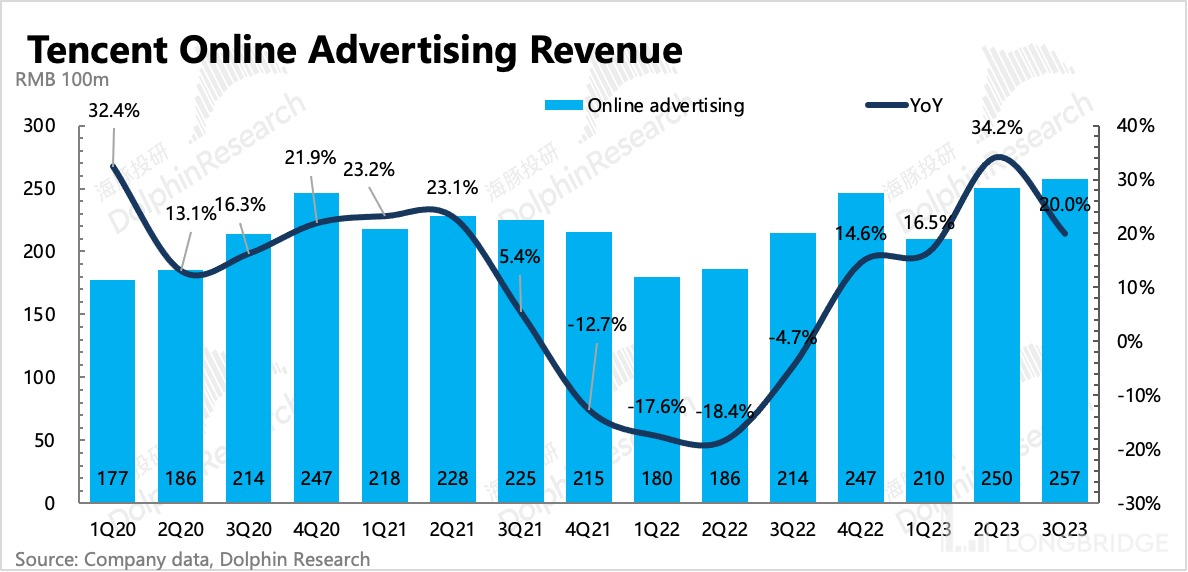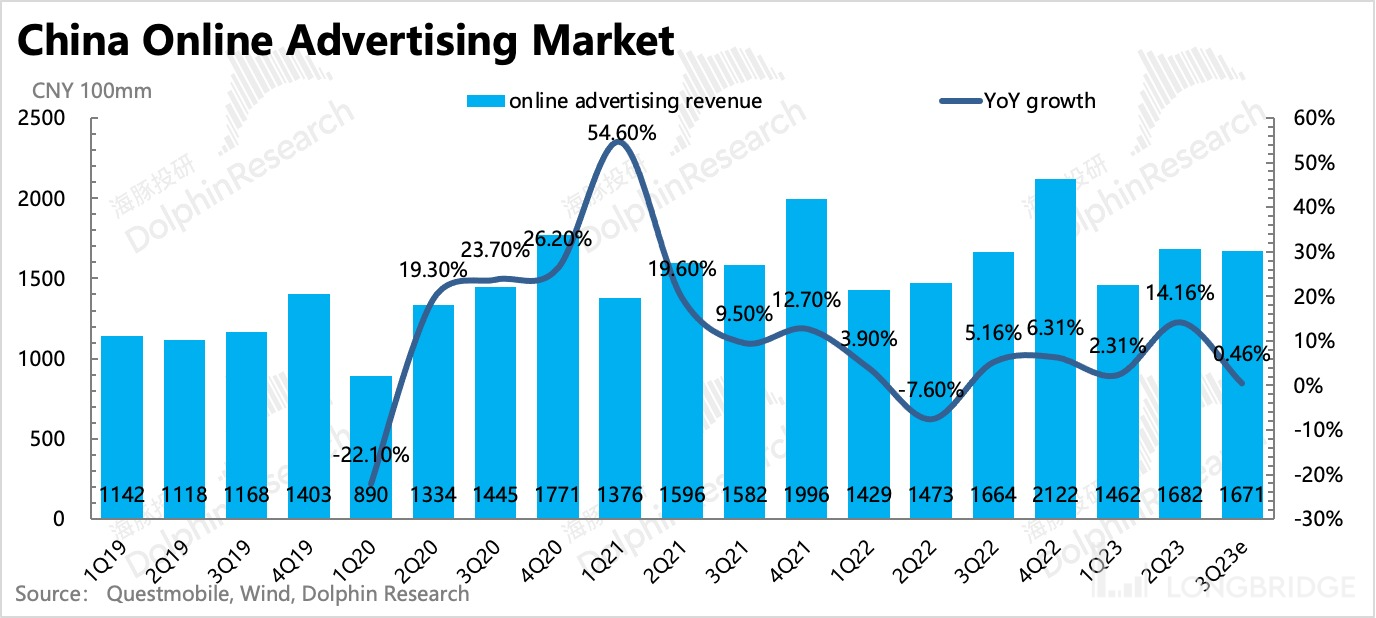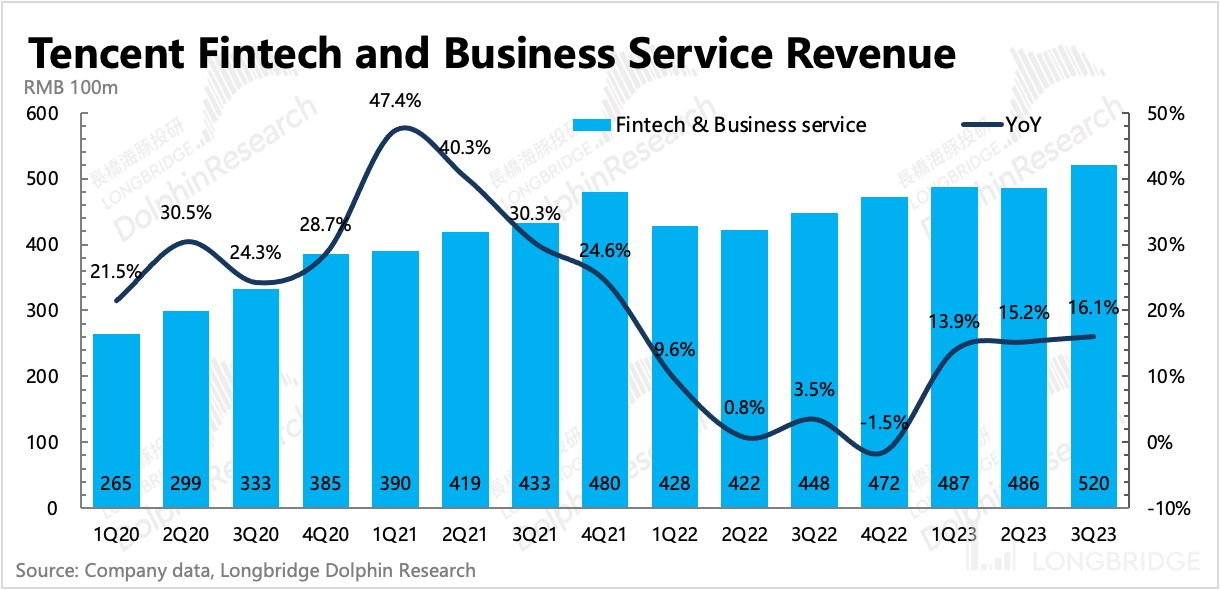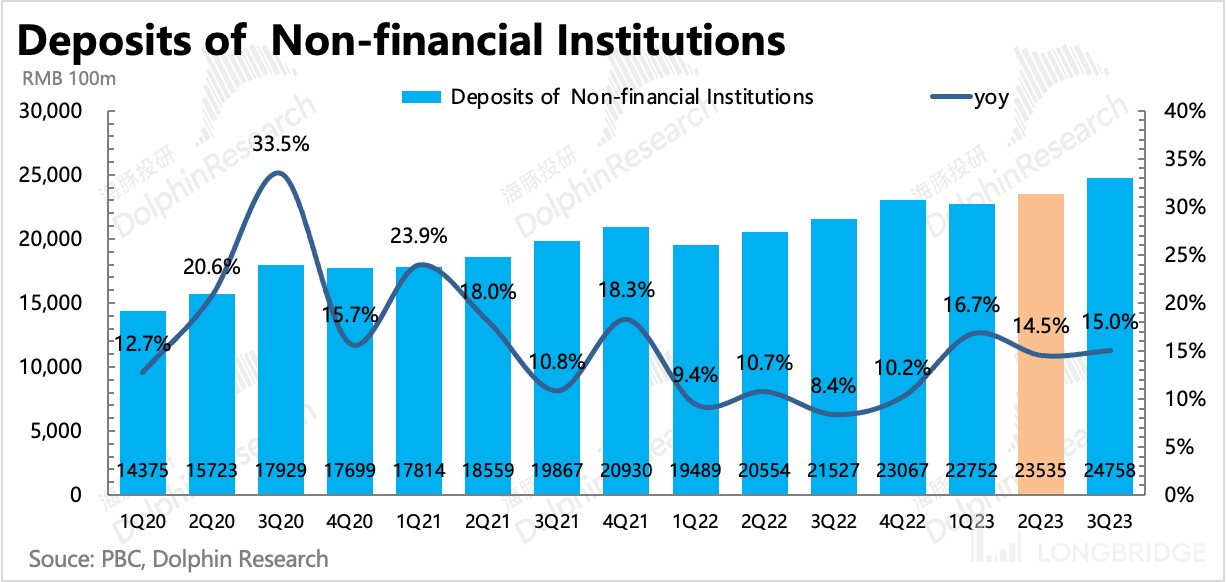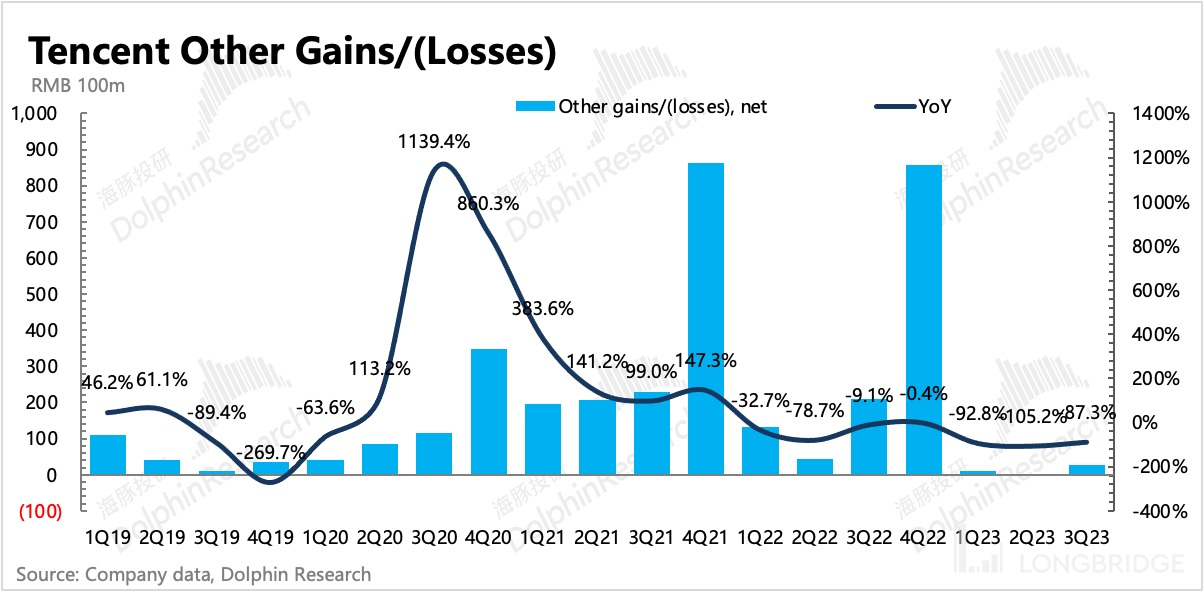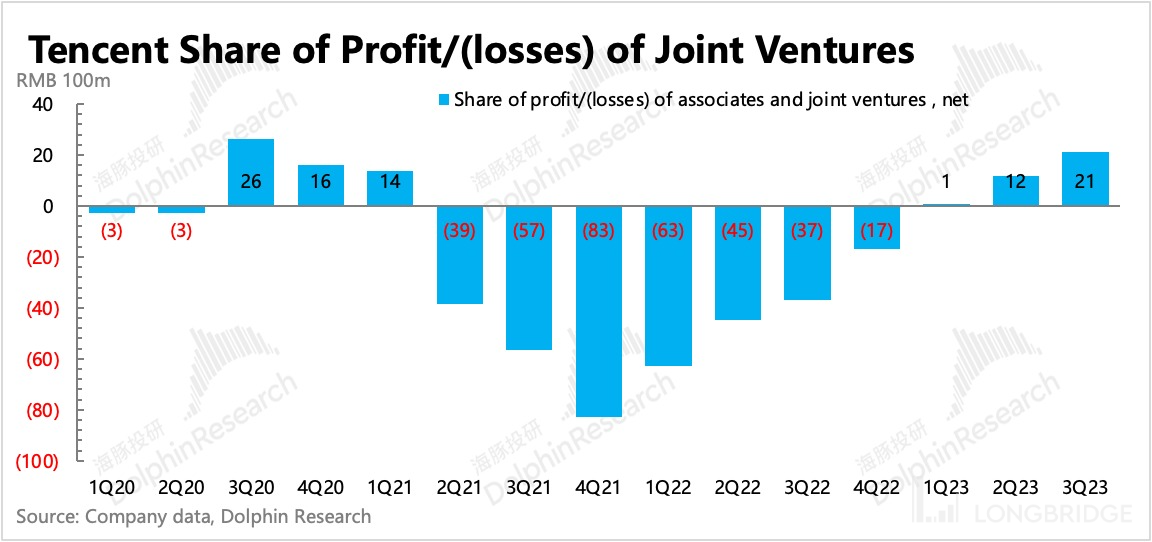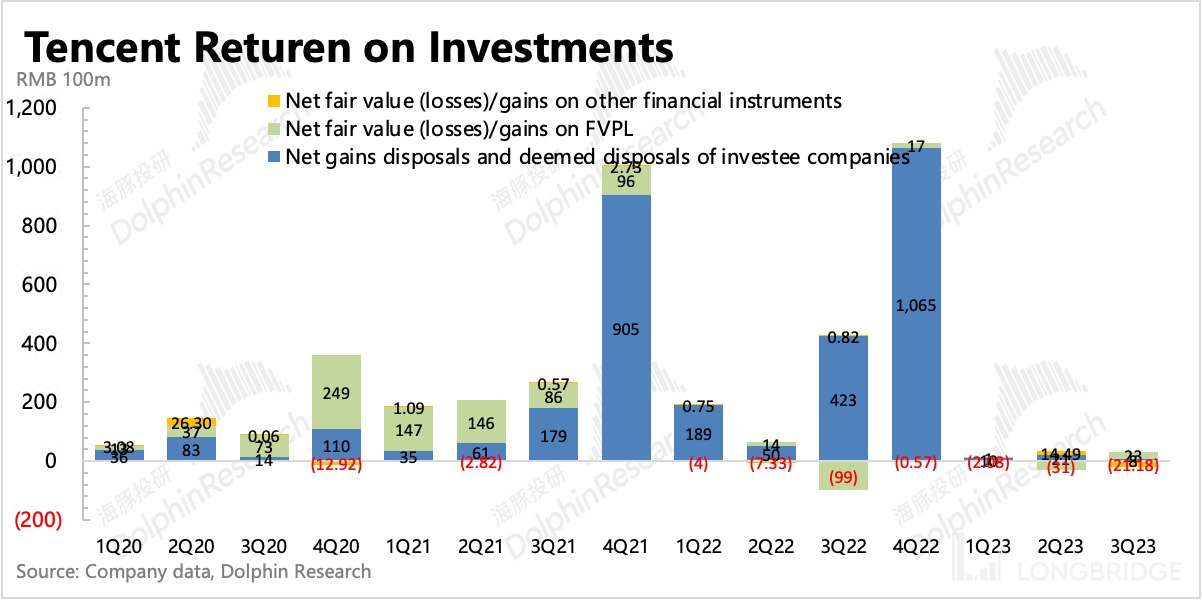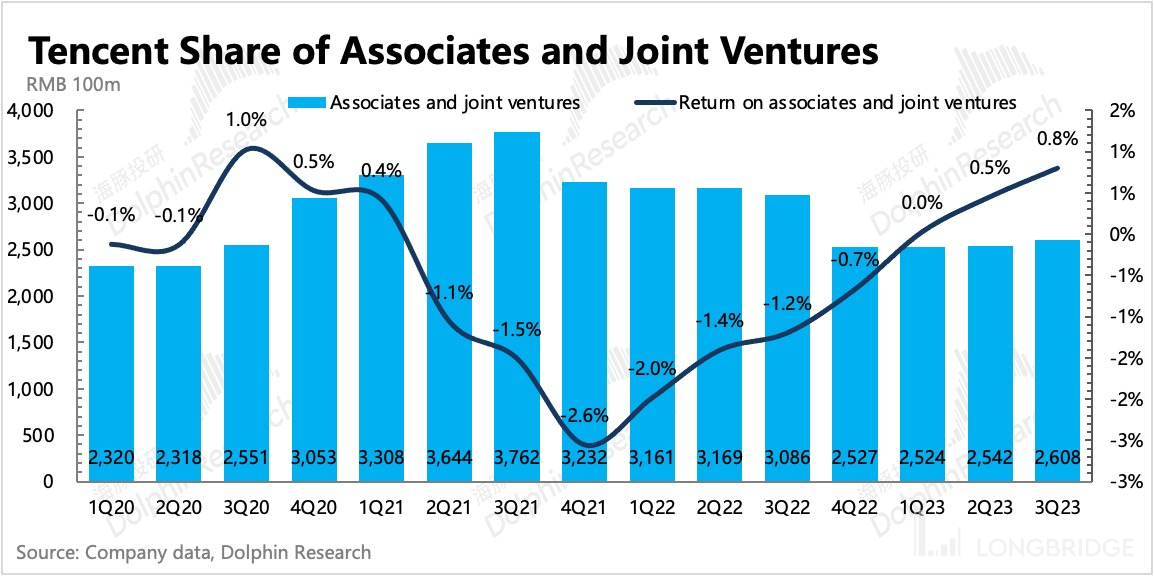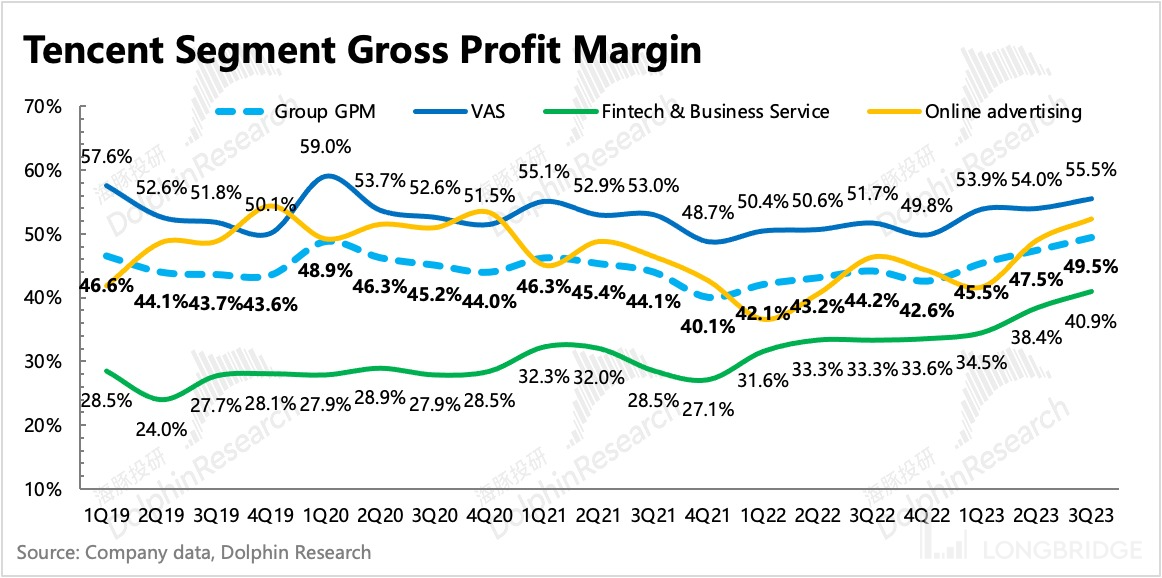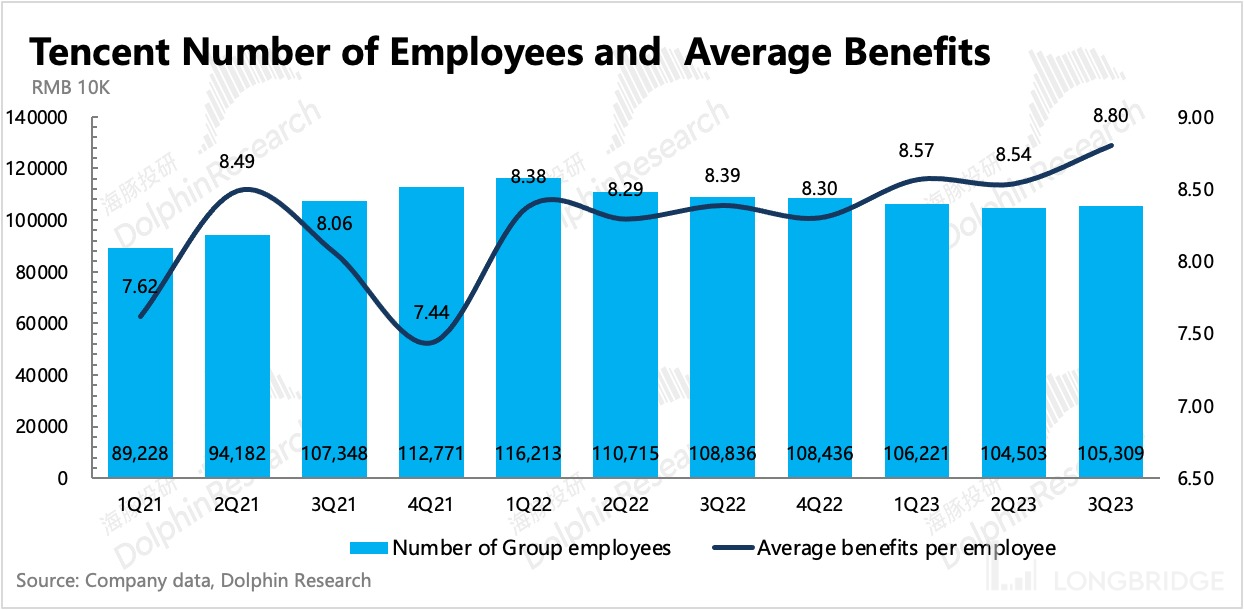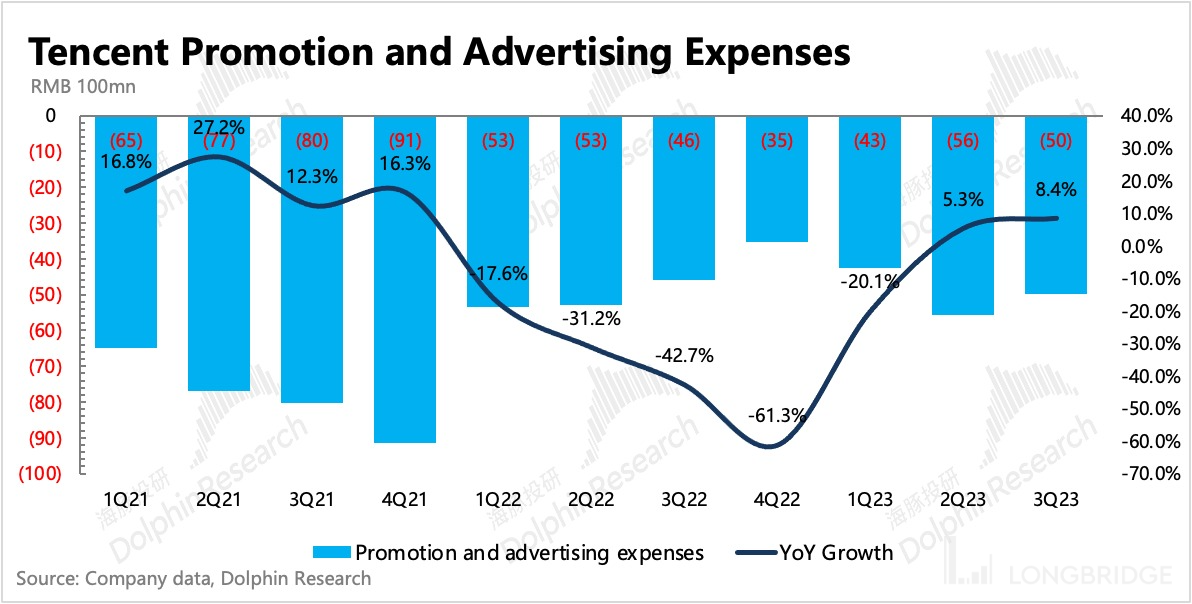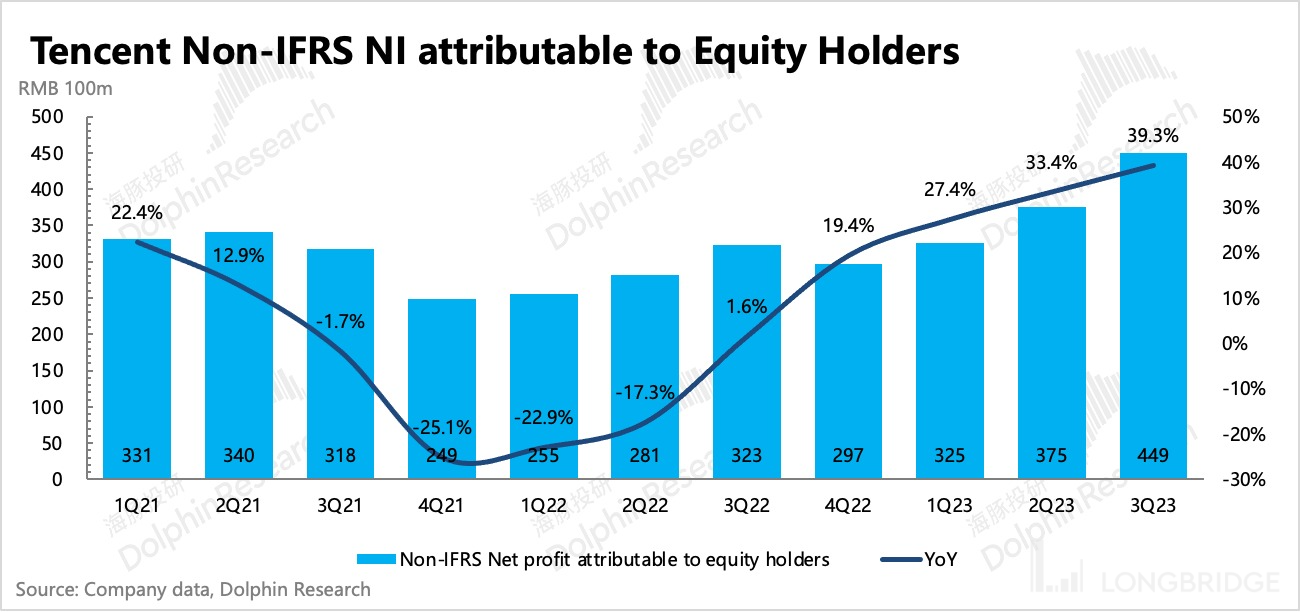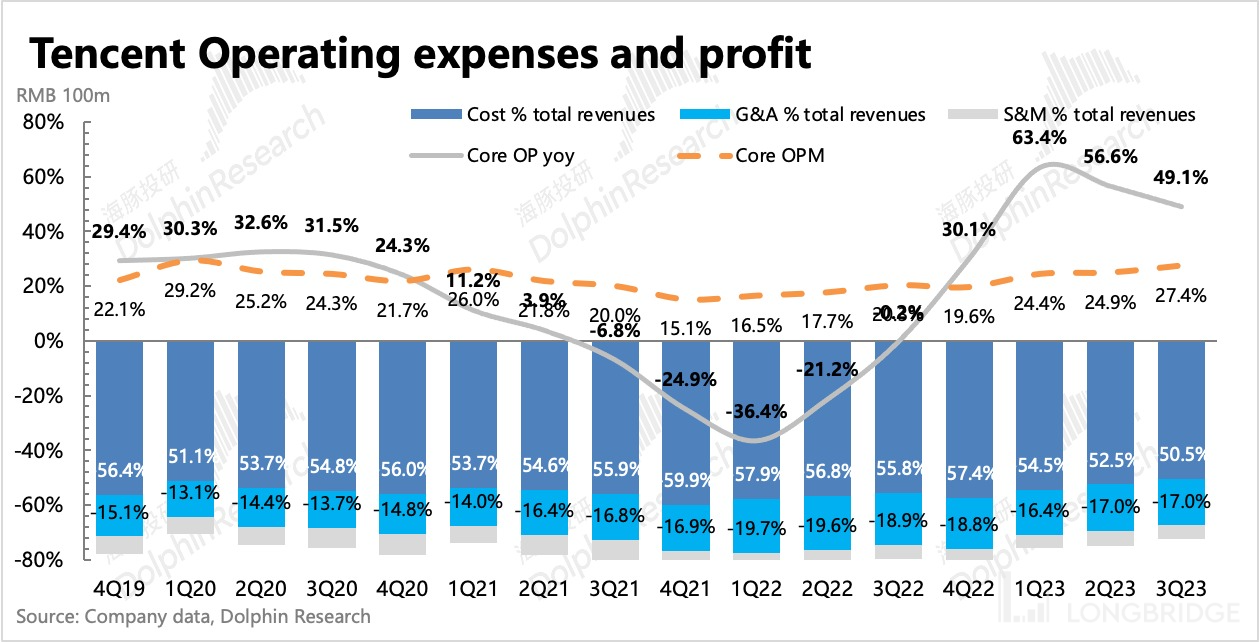
 Likes Received
Likes Received Posts
PostsSaving money "middle-aged" TENCENT: Can't keep up, can only cut back, cut back, cut back

After the Hong Kong stock market closed on November 15th, the third-quarter earnings report of Tencent, the king of stocks, was released. It is still a "moderate growth but doubled profits" performance.
Here are the key points:
1.Profit Soars Again: Despite the moderate growth, revenue has maintained a steady growth rate of just over 10% for four consecutive quarters. However, the king of stocks continues to demonstrate its unbeatable profit-making ability, with a year-on-year increase of 49% in core operating profit in the third quarter, significantly exceeding expectations.
The better-than-expected profit is mainly attributed to cost optimization, especially the decline in bandwidth costs. While promotional expenses have decreased, employee compensation has increased on a quarter-on-quarter basis due to the expansion of new businesses, offsetting the year-on-year decline. Therefore, the adjusted net profit attributable to shareholders, which the market is particularly concerned about, has naturally accelerated to 44.9 billion, with a growth rate of 39.3%.
2.Mixed Performance in Different Business Segments
(1) Fintech and Cloud Outperform: Let's start with the good performers. The growth of Fintech and Cloud is the main business that exceeded revenue expectations this time. Originally, the market did not have high expectations for Fintech business due to the dismal performance of online social retailing in July and August, as well as the news of adjustments and optimizations in cloud business. A growth rate of just over 10% was considered satisfactory.
However, the actual growth rate is 16%. Dolphin Research believes that in addition to the naturally favorable offline consumption and the advantage of offline payment scenarios possessed by Tenpay, the remaining incremental growth should mainly come from the commission fees of video accounts that started charging at the beginning of the year.
However, the credit products that Dolphin Research previously focused on, such as Fenfu and Fenqi (refer to "In-depth Analysis of Tencent Fintech Second Spring by Learning from Ant Group?"), are still in small-scale testing this quarter, and it will take some time before they are reflected in financial indicators.
(2) Advertising a Bit Disappointing: Advertising revenue did not continue the surprise of the previous quarter, with a growth rate of 20% slightly lower than the consensus expectations and lower than the guidance given after the second quarter report. This may be a slight disappointment for the market.
Since the fourth quarter of last year, Tencent's advertising business has continuously brought surprises, not only emerging from the shadow of the epidemic the fastest but also quickly returning to high-speed growth. The main driving force behind this is the WeChat ecosystem, including the incremental growth of video accounts.
In addition to increasing its own advertising inventory through video accounts, the deeper logic is that Douyin has grown too rapidly, intensifying competition in e-commerce, and the demand for traffic from traditional platforms has reached its peak. Therefore, Tencent, which has the largest traffic scale but is not a direct competitor, has become a must-have channel for various advertisers. Obviously, the market in the third quarter still believes in this logic, so there were high expectations for Tencent's advertising revenue growth, even though it was adjusted downward after the preview, it was still expected to be above 20%.
However, Dolphin Research believes that although there is a slight disappointment, we still have confidence in the future growth and the commercialization potential of WeChat, especially with the expansion of video commerce. The private domain ecosystem built around mini-programs, WeChat Pay, video commerce, enterprise WeChat, and WeChat groups is expected to attract more merchants.
(3) Dragging behind in value-added expectations: The performance of value-added paid services has been relatively lackluster in the past two years, except for the double-digit growth in the first quarter of this year due to the success of "King of Glory".
In the third quarter, it grew by 4.2%, with a slight rebound compared to the previous quarter. The main reasons for this are the lack of new local games (with only one PC game and two mobile games, one of which was launched at the end of the quarter and contributed little), adjustments to Tencent Music's live streaming business, and the continued weakness of Tencent Video.
Although VAS revenue fell short of expectations, Dolphin Research compared the preview and found that the management's statement was relatively conservative, and the expectations of core investment banks were not high either. Therefore, it cannot be considered a complete miss, but it still cannot escape the "dragging behind" accusation.
Considering the situation of deferred revenue and the upcoming game pipeline, we believe that in the short term, VAS may still face pressure due to live streaming adjustments, weak long videos, and a lack of potential blockbuster games. However, the low base may provide some support. But it is expected that a more significant rebound will not be seen until next year, such as the launch of the highly anticipated game "Dream Star" based on the popular game "King of Glory".
Share repurchase: In the first half of the year, the company repurchased a total of 47.5 million shares, consuming HKD 15.3 billion. The repurchased shares have been cancelled, and the diluted share capital has decreased by 30 million shares compared to the previous quarter. As we expected last quarter, under the continuous selling pressure from major shareholders, Tencent's repurchase efforts in the third quarter have significantly increased (similar to the total repurchase volume of the first two quarters of the year).
Detailed financial data overview

Dolphin Research's viewpoint
There is no denying that the performance is not perfect, but there is nothing particularly critical to pick on. Even though the value-added business has been lagging behind, for a stock king with quarterly revenue exceeding 150 billion, achieving over 20% growth with only deep cultivation in the domestic market may require the next "King of Glory", installment payments, or a completely new industrial technological revolution, such as AI.
Of course, we still have expectations for the commercial value of the WeChat ecosystem, but the management's attitude may not be so utilitarian and impatient. Instead, they choose to gradually and deeply penetrate, such as the ad loading rate for video accounts. The company has its own pace and does not push the accelerator to the maximum. But looking at these past few quarters, we also find that, by continuously leveraging the scale effect of platform companies, Tencent has demonstrated its enviable ability to generate profits. If it continues to increase share buybacks or raise dividends, it will still be an attractive investment target for investors.
Currently, its market value is HKD 3.07 trillion, corresponding to a Non-IFRS net profit multiple of 19 times this year, which is still at a median level. The key is that this only reflects the value of its core business, while Tencent still has a stock asset value of nearly HKD 700 billion (estimated by Dolphin Research and given an 80% discount) and a net cash of nearly HKD 40 billion, which has not been priced reasonably.
The following is a detailed analysis:
1.User ecosystem: WeChat continues to grow steadily, while QQ declines during peak season
In the third quarter, WeChat added 9 million net new users, maintaining stable expansion, reaching 1.336 billion at the end of the quarter. However, during the peak season of the third quarter, QQ users still decreased by 13 million compared to the previous quarter.
The stable traffic of WeChat can support the continuous deepening of its commercialization, but the younger demographic is decreasing and it seems that QQ is unable to change the trend of user loss.


2.Impact of live streaming, slow recovery in gaming
In the third quarter, Tencent's online gaming revenue was CNY 46 billion, a year-on-year increase of 7.3%, showing some signs of recovery compared to the second quarter. Of course, the second quarter had reasons for actively adjusting the pace of commercialization, and the third quarter was a peak season plus normal commercialization, so the recovery was within expectations.

Looking at the details, the growth rate of domestic games is still weaker than that of overseas games, but in terms of MoM trend, the growth rate of domestic games has increased from 0.1% in the second quarter to 4.8%. The aforementioned pace of commercialization mainly focuses on the domestic gaming market. Overseas games are gradually moving away from the low base effect, and the growth rate continues to slow down to 13.7%, which is basically in line with expectations.
However, compared to the industry, Tencent's gaming performance is still lagging behind. Currently, CNG has only disclosed the growth rates for July and August (51.1% and 63.7% respectively), but the signs of explosive recovery in the industry are already very obvious.

In the third quarter, although there were new games such as "<Valorant>," "Apex Legends" and "MapleStory M" the first one is a PC game. Despite its high popularity, the user coverage of PC games is still not as extensive as that of mobile games, and the revenue scale is also one level lower. "High Energy Heroes" didn't contribute much in the third quarter since it was just launched, while the popularity of "Adventure King" exceeded the company's expectations, but its revenue scale cannot make up for the decline in several top-performing old games.
However, in terms of old games, "King of Glory" maintained positive growth after returning to its normal commercial rhythm in the third quarter, stabilizing the foundation of domestic games.
As for overseas games, due to the weakening of the low base effect, the year-on-year growth rate slowed down to 13.7% (excluding the impact of exchange rates, the year-on-year growth rate was +7%), achieving a revenue of 13.3 billion, which basically met expectations. The revenue of overseas games in the third quarter still relied on contributions from "Valorant," "Triple Match 3D," and "Goddess of Victory: Niki," and the recovery of revenue from "PUBG Mobile" was also a crucial factor. If Tencent's overseas game performance is compared within the industry, it can still be considered excellent.

Looking ahead to Q4 and next year, Dolphin Research believes that although Tencent Games has a considerable pipeline, there are not many with the potential to become explosive hits, especially considering Tencent Games' quarterly game revenue of nearly 50 billion. However, the low base effect and the cyclical recovery of the overseas game market may provide some support for Q4's growth rate. However, from the perspective of deferred revenue (a 4.8% decrease MoM), we remain cautiously optimistic. Of course, deferred revenue not only includes games but also includes revenue from music subscriptions, long video subscriptions, and live streaming rewards, but games still account for the majority.

However, the hope for growth next year may still mainly rely on "Star of Dreams," a social party game that integrates the IP of "King of Glory," similar to NetEase's "Egg Party." It goes without saying how lucrative "Egg Party" is, and with the help of Tencent's own social traffic advantage, Dolphin Research is very much looking forward to this game.


3. Disappointing Advertising Performance, Industry Factors at Play
Tencent's advertising revenue growth slowed down in the third quarter and did not exceed expectations as before. However, in the business logic believed by the market, Tencent's advertising Alpha effect has been very significant this year, so there were high expectations before. Even though the management lowered the guidance a month ago, the market still expected some surprises.
But the actual performance still fell short of expectations, with advertising revenue reaching 25.7 billion in the third quarter, a YoY growth of 20%. According to the disclosed information in the earnings report, it was said that the contribution of video ads had significantly increased, so it was expected that the contribution of video ads in the third quarter would also see a noticeable improvement. Roughly speaking, excluding the incremental impact of video ads, the remaining advertising growth rate may have fallen to single digits.
On the other hand, it is possible that traditional media advertising has weakened again. Yesterday's earnings report from TME also showed that the growth rate of other online music revenue, including advertising revenue, has slowed down significantly MoM, which is also lower than market expectations.
Looking at the industry comparison, the performance of the online retail industry in the third quarter was mediocre, especially for online retail. Therefore, the performance of the online advertising industry was also poor, with almost no YoY growth.


Looking ahead to the fourth quarter, we believe that the ongoing escalation of the e-commerce war will allow platforms such as Tencent, Bilibili, and Xiaohongshu to benefit greatly. After the 618 Shopping Festival, Alibaba has also joined hands with Tencent to actively prepare for the Double 11 Shopping Festival. Based on the recent situation, we believe that there is no need to be too pessimistic about the fourth quarter, but the growth rate may continue to slow down due to the high base.
4. Fintech and Business Services Bounces Back and Accelerates Growth
In the third quarter, Fintech and Business Services' revenue grew by 16%, exceeding expectations and making up for the significant miss in the previous quarter.
In terms of Fintech, although online retail was weak, WeChat Pay's advantage lies in offline consumption scenarios, so it fully leveraged its strengths and outperformed the industry (+15%).
As for Enterprise Services, growth accelerated in the third quarter, mainly due to the rapid recovery of cloud services and the additional revenue brought by video ads.


5. Investment Ventures Continue to Improve Profitability
In the third quarter, Tencent's investment income outside its main business was still not significant, but it increased by nearly 3 billion compared to the previous quarter.

Among them, the contribution from joint ventures and associates was the main factor, with a profit of 2.1 billion in the third quarter. Compared to 100 million in the first quarter and 1.2 billion in the second quarter, it continued to increase. After the affiliated companies started to seek their own development, their self-generating capabilities have also been demonstrated. The changes in other financial assets are within the normal fluctuation range, and there is no need to pay too much attention to the changes in individual quarters.


As of the end of the third quarter, the company's joint venture/associate assets amounted to 260.8 billion, with a profit of 2.1 billion for the current period. The investment return rate for the quarter continued to increase to 0.8%.

6. Explosive profits highlight the scale advantage of the platform.
The profit in the third quarter once again significantly exceeded expectations. In terms of expenditure details, in addition to the optimization of some content costs and the reduction of intangible asset amortization, the improvement in gross profit margin due to the optimization of server bandwidth costs is still the core key to improving overall profitability.
We attribute this to the scale effect of platform-based companies. Therefore, in the third quarter, in addition to the sluggish growth in value-added business revenue, advertising and financial technology services continued to improve. Of course, if we are more specific, the improvement in advertising gross profit margin is due to the monetization of video accounts, which has alleviated the previous drag on gross profit margin. The improvement in financial technology services gross profit margin is more related to the self-adjustment of cloud services (reducing low-margin subcontracting business), thereby optimizing the related server costs.

However, in terms of expenses, although the total R&D and management expenses still declined year-on-year, the decline has approached zero. From a quarter-on-quarter perspective, the number of employees has increased by more than 800 compared to the previous quarter, and average benefits have also increased. As Dolphin Research predicted last quarter, the cost control cycle is coming to an end, and Tencent is gradually returning to business expansion investment. Of course, this kind of investment will definitely not be the same as the previous years' massive investment. On the one hand, there are regulatory restrictions (such as anti-monopoly), and on the other hand, it is due to the group's stricter control over profit fluctuations. Based on the attitude of steady operation and responsibility to shareholders, the group will still maintain the improvement of operational efficiency during business expansion.

In the third quarter, the continuous slow growth of promotion expenses helped increase the core operating profit margin by 0.5 percentage points compared to the previous quarter, and another 2 percentage points came from gross profit margin. Of course, promotion expenses are generally related to the launch of new games, new films and TV shows, new cloud service tools, and other new products. Especially during the period of intensive launch of new games, marketing expenses tend to increase, so they still have short-term volatility. In addition, Tencent's sales expense ratio is only 5%, which is already low enough and may not have a continuous optimization trend in the long run.

In the end, the third quarter achieved a Non-IFRS net profit attributable to equity holders of 44.9 billion, a year-on-year growth of 39%, exceeding market expectations. Dolphin Research also pays attention to the operating profit of the main business. In the third quarter, it increased by 49.1% year-on-year, also better than expected.


7. Selling Pressure and Repurchase: Repurchase Doubled, but Major Shareholders Continue to Sell
As we expected last quarter, Tencent increased its repurchase efforts in the third quarter, doubling the intensity compared to the first two quarters of the year. In the first half of the year, the company repurchased 48 million shares in 6 months, consuming HKD 16.9 billion. In the third quarter, it repurchased 47 million shares in 3 months, consuming HKD 15.3 billion, and the repurchased shares have been cancelled.
Compared to our statistics in mid-August, major shareholder Prosus has sold 400,000 shares in the three-month period from August 16 to the present, basically following the pace of selling more than 100,000 shares per month this year. The current shareholding ratio has dropped to 25.14%.

For more information on repurchases and sales, please refer to the analysis report "Tencent: Major Shareholders Keep Selling, Can the Stock King Still Have Faith?". Due to space limitations, I will not elaborate on the latest repurchase data and major shareholder selling pressure here. We will regularly update them in the "In-depth Data" section.
Dolphin Research "Tencent Holdings" related articles:
Earnings Season (past year)
August 17, 2023 Conference Call: "Focus on the Commercial Value of Mini Games (Tencent 2Q23 Conference Call Summary)"
August 16, 2023 Earnings Review: "Tencent Fell into a Pit Again? Minor Flaws Can't Change the Nature of the Stock King"
May 17, 2023 Conference Call: "Positive Outlook, but Still Cost Control (Tencent 1Q23 Conference Call Summary)"
May 17, 2023 Earnings Review: "No Surprises from Tencent? The Stock King's Golden Quality Can't Be Hidden"
March 22, 2023 Conference Call: "Beyond the Core Business, Tencent Sets Its Sights on Live E-commerce and AI (4Q22 Conference Call Summary)"
March 22, 2023 Earnings Review: "Tencent: Are Chinese Concept Stocks Collapsing One After Another? The Stock King Remains Stable"
November 17, 2022 Conference Call: "Tencent: Smooth Progress in Monetizing Video Accounts, Game Licenses Expected Soon (3Q22 Conference Call Summary)"
November 16, 2022 Earnings Review: "Tencent: WeChat's Gold Mine, Making Money as the Stock King Is Not Difficult"
August 18, 2022 Conference Call: "Cost Reduction and Efficiency Improvement to Continue in the Second Half, High Expectations for Video Accounts (Tencent 2Q22 Conference Call Summary)"
August 17, 2022 Earnings Review: "A 360-Degree Breakdown of Tencent: Is It Really That Bad?" 2022 年 5 月 18 日电话会《对今年的增长指引取决于疫情(腾讯电话会)》
2022 年 5 月 18 日财报点评《腾讯:股王还在渡劫》
2022 年 3 月 23 日电话会《行业降速下,高质、健康的增长是第一位(腾讯电话会纪要)》
2022 年 3 月 23 日财报点评《腾讯:股王照样 “深蹲”?考验信仰的时刻到了》
** 深度 **
2023 年 1 月 6 日《泛娱乐 “开门红”,腾讯、B 站们谁的反弹更持久?》
2022 年 9 月 28 日《重拾腾讯,探探股王的 “底”》
2022 年 1 月 5 日《“小腾讯” 被抛吓坏腾讯小兄弟? Sea 这事意义不一样》
2021 年 6 月 28 日《“鸡肋” 的腾讯背后:终究还是对支付下手了!| Dolphin Research》
2021 年 6 月 20 日《腾讯下一站:万亿市值?(下)| Dolphin Research》
2021 年 6 月 10 日《腾讯下一站:万亿市值?》
2021 年 5 月 19 日《监管落地之前,新一轮变革后的腾讯能否顶住压力?|巨头前瞻》
2021 年 5 月 5 日《流量产权战:商家入局,腾讯得意 | 调研纪要》
** 热点 **
2023 年 7 月 19 日《腾讯:大股东抛抛抛,股王还能有信仰吗?》 On January 17, 2022, Dolphin Research published an article titled "The Butterfly Effect of Ant Group: Will Meituan and Pinduoduo be Left Behind by Tencent?".
On January 12, 2022, Dolphin Research published an article titled "Revisiting the Value of Tencent's 'Half-Life'".
On December 23, 2021, Dolphin Research published an article titled "Tencent Says Goodbye to JD.com: A Happy Breakup or a Painful Letting Go?".
On December 14, 2021, Dolphin Research published an article titled "Is Tencent's Stock Price Bottoming Out as Regulatory Pressure Eases?".
Please refer to the risk disclosure and disclaimer in this article: Dolphin Research Disclaimer and General Disclosure.
The copyright of this article belongs to the original author/organization.
The views expressed herein are solely those of the author and do not reflect the stance of the platform. The content is intended for investment reference purposes only and shall not be considered as investment advice. Please contact us if you have any questions or suggestions regarding the content services provided by the platform.

